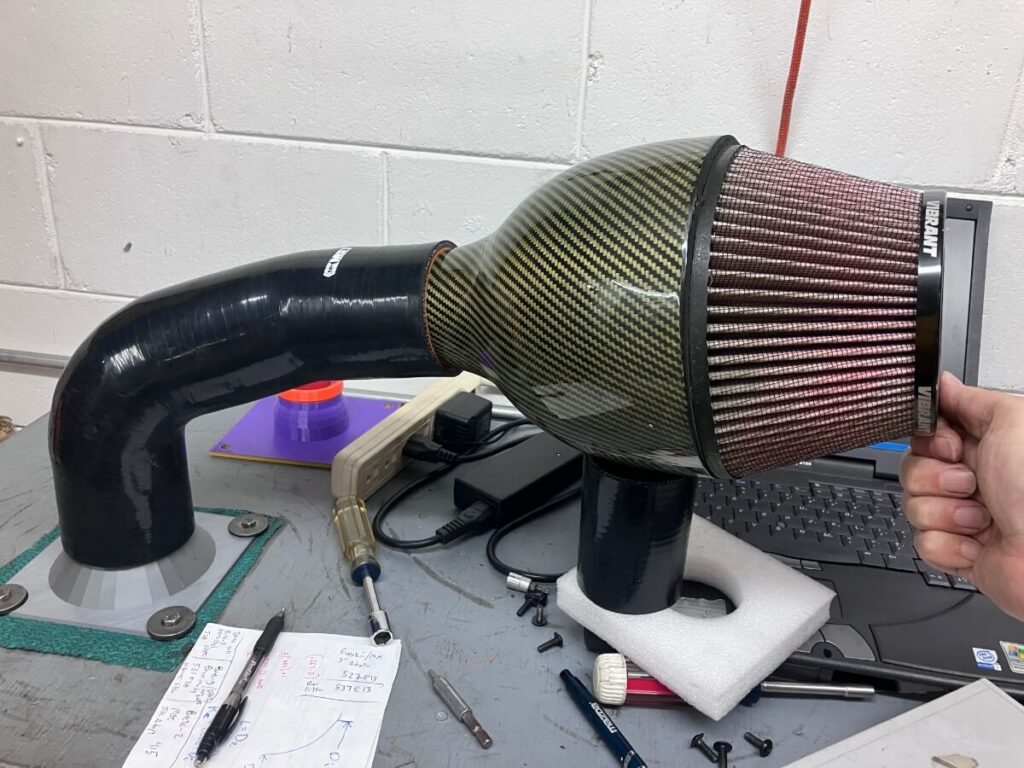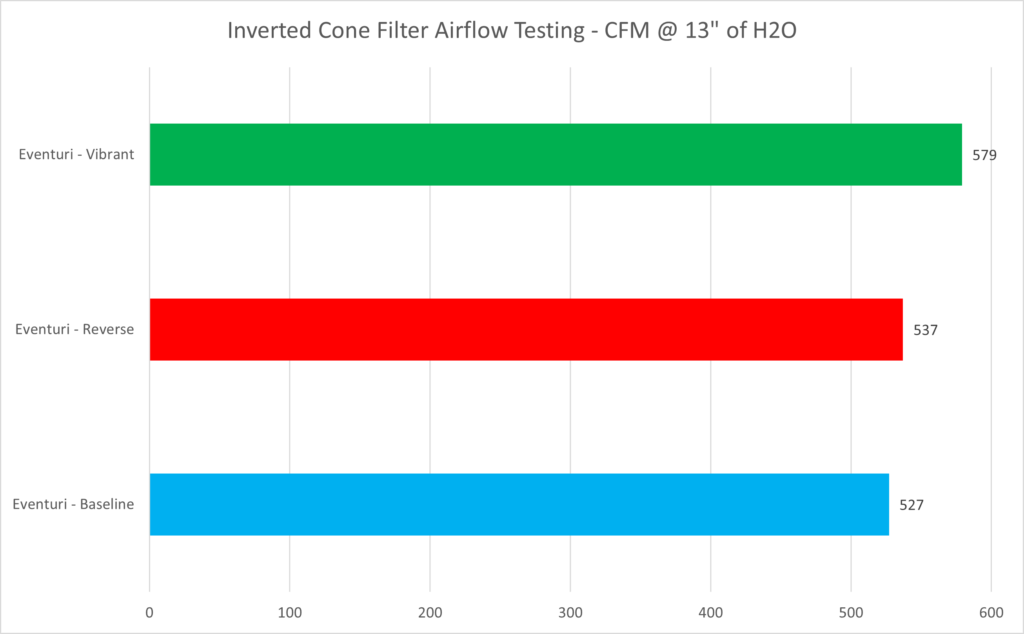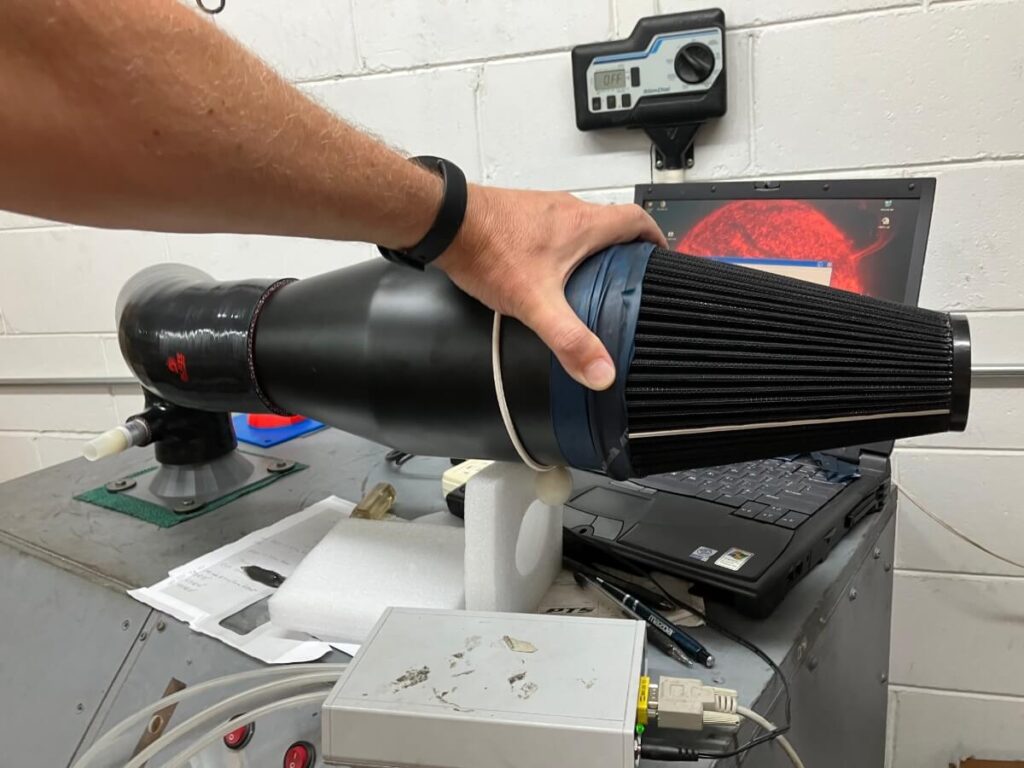Background:
As part of my project designing an intake, a decision about the type of air filter was needed. Most aftermarket intakes I have tested use a cone-style filter, and the abundance of options makes sourcing a filter that would fit my prototype easier.
The intake I am presently using on my GTI is from Eventuri and it uses an inverted cone filter that is reversed from the normal configuration the filter on a stick type intakes use.
Eventuri has some nice diagrams showing the supposed benefits of their reverse filter design, but I was interested in finding out if the reverse filter produces any improvement in airflow compared to the more common filter orientation.
Test Setup:
To test the effect of the filter orientation the Eventuri intake is attached to a PTS flow bench to measure the airflow through the intake with the filter oriented in the intended direction, followed by a test with the filter reversed as shown below:

A second check of the intake is made using a Vibrant 10960 air filter. This is a conventional cone filter with a larger filter cap outside diameter than the Eventuri air filter.
This configuration is shown below:

The Eventuri intake is attached to the flow bench using an MST silicone coupler hose and a 3″ adapter plate.
Note: This configuration eliminates the turbo inlet elbow which is the greatest source of pressure loss in the pre-turbocharger intake.
Testing is performed at a depression of 13″ of H2O and the measured airflow rate at this pressure is recorded.
Test Results:
The Eventuri intake with filter oriented in the design direction flows 527 CFM @ 13″ of H2O.
Reversing the Eventuri air filter results in a 1.9% increase in airflow up to 537 CFM @ 13″ of H2O.
Replacing the Eventuri air filter with the Vibrant 10960 air filter resulted in a 9.9% gain versus the original configuration. Airflow rate is 579 CFM @ 13″ of H2O.

Previous test:
Reviewing previous test results made with another intake that uses a reverse cone filter design, Blaze ATOM V2, showed that reversing the direction of the Blaze cone filter resulted in an 11.3% increase in airflow rate, going from 453 CFM @ 10″ of H2O to 504 CFM at the same depression.


Conclusions:
Tests performed with cone-style air filters showed that an inverted filter design reduces airflow through the filter compared with the air filter oriented in a more common direction.
Reversing the direction of an inverted cone filter corresponded with airflow gains of approximately 10%.
Speculation:
Why is the inverted cone filter design inferior to a standard orientation cone filter concerning airflow? Two possible reasons for this are as follows.
The inverted cone filter acts like a funnel and the air that passes through the filter material further in the filter is traveling faster than the air closer to the inlet. Pressure losses increase in proportion to the square of the airflow velocity, which means that the filter design results in a flow velocity increase before the air passes through the filtering medium, increasing pressure losses.
A conventional cone filter promotes a low airflow speed through the filtering medium, lowering pressure losses compared to the reverse filter design.
A second possible reason is that as the air travels down the cone filter inlet the momentum of the air is in a direction that is not perpendicular to the filtering medium. This would result in the air passing through the filtering material at an angle less than 90 degrees. (Think of this like drilling through a piece of wood at an angle). This passage at an acute angle means the air needs to pass through more filter material. As the thickness of the material increases, due to passage at an angle, so does the resistance to the airflow passage. Resistance to airflow is what causes pressure loss.
With a conventionally oriented cone filter, the air can pass perpendicularly through the filtering material, minimizing the amount of material the air passes through compared to passing through the material at an angle.
